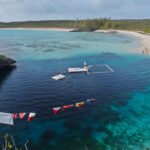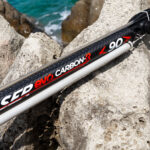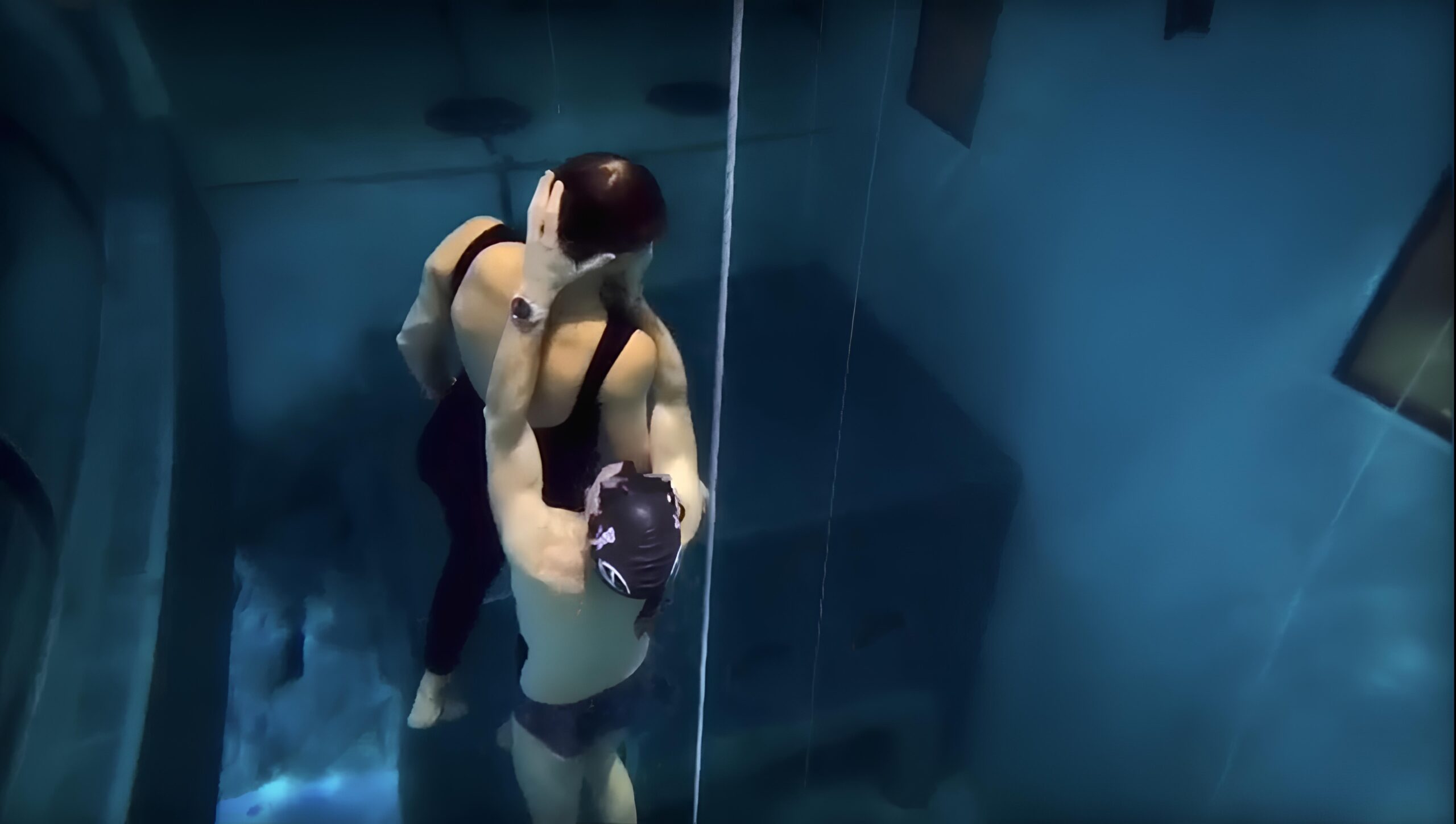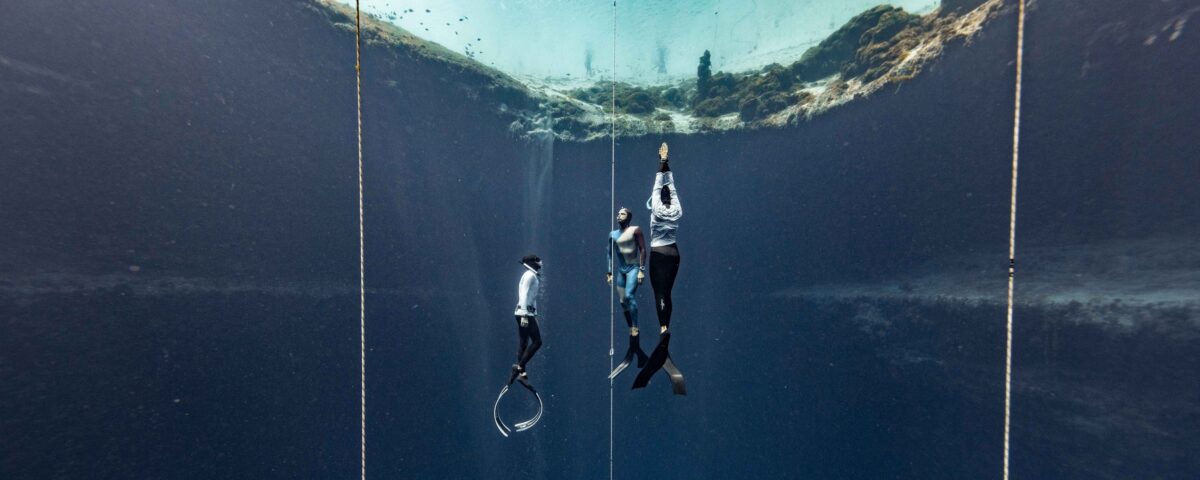Francesco Corucci: Let’s Talk About Safety

Vertical Blue 2025: The Blue That Rewrites Records
14 July 2025
Pathos: Laser Evo Carbon Roller
25 July 2025On April 12–13, an advanced course on freediving safety was held at Y-40, part of a global initiative promoted by AIDA International in collaboration with Vertical Blue. We took the opportunity to sit down with Francesco Corucci—an internationally recognized safety diver and member of AIDA’s Safety and Education Commissions—who played a key role in developing this initiative
Gabriela Felicioni
To begin, tell us a bit about yourself and your freediving journey.
“I’m originally from Pisa but now based in Livorno (much to the dismay of local patriots, he laughs). I started freediving over 10 years ago, and I’ve been focusing on safety since 2019. In what now feels like a past life, I was an IT engineer and university researcher (working on biorobotics and artificial intelligence). However, in 2022, I decided to leave my technical and academic career behind to fully dedicate myself to my greatest passion—freediving.
“This discipline has given me so much—it’s changed who I am as a person and, during a tough period in my life, became a path to recovery and healing.
“I’m based in Livorno, where in 2020 I founded Deep Instinct Freediving. I’m an Instructor Trainer, first aid instructor, and since 2022 I’ve been collaborating with AIDA International on the Safety and Education commissions. This lets me actively contribute to the development of global initiatives, content, and safety protocols. Since 2021, I’ve had the opportunity to work at the highest levels of freediving safety, serving as safety diver and safety team leader at all the major international competitions—Vertical Blue, multiple World Championships under both AIDA and CMAS.”
What got you interested in safety?
“It was the 2018–2019 season. The group I was training with wasn’t very active during summer, so a few freediving friends and I bought a buoy and started heading out to sea on our own. None of us were instructors at the time. The atmosphere was relaxed—sunset sessions after work became a pleasant ritual. We were diving to depths of 40–45 meters (the deepest we could find), and our dive times were quite long.
“But I started having doubts about our safety—what if something unexpected happened? Would we actually be prepared to deal with it, based on what we’d learned in our courses? In my mind, the answer started to solidify into a ‘no.’
“The more we dived, the more I felt that we weren’t adequately prepared—something was missing, both in terms of technical knowledge and the right mindset. And this wasn’t just our case—overall, the safety and rescue training we’d received as students was minimal, and the way risk was handled felt more like a mix of anxiety, insecurity, and psychological pressure.
“So I started doing my own research. Soon our buoy featured a lanyard (we had never seen one used before), then the first stopper at the bottom of the line—this after I’d gotten tangled in a poorly rigged rope beyond 40 meters during a course (luckily it ended without consequences).
“Despite the increasingly professional setups and more structured sessions, I still felt something was missing. Then I saw a poster for the very first Professional Safety Freediver (PSF) course by my friend Marco Cosentino, held at Y-40. I’d never been into competitions and had no idea what being a safety diver really meant—but it seemed like the right place to learn what I needed, so I signed up.
“It was an amazing but demanding course, with high standards that have proven hard to maintain over time due to the difficulty in finding candidates at the expected level. But I found the technical skills I was looking for and—more importantly—I felt that ‘click’ in terms of mindset.
“I realized that being a safety diver is an incredibly demanding job—physically, technically, and emotionally. But it felt right for me, so I started thinking about joining real competitions. A few years later, I’ve now had the chance to prove myself at the top events, facing intense situations that helped me grow enormously as a safety diver, freediver, and instructor. More recently, I had the honor of helping AIDA International expand and standardize the PSF program... and here we are.”
Tell us about this most recent safety course.
“The course is part of a program called AIDA Competition Safety Freediver by Vertical Blue – Professional Safety Freediver. It’s a collaboration between AIDA International and Vertical Blue, in which the PSF curriculum has been revised, standardized, and expanded to scale globally.
“The overall initiative includes three different courses covering both indoor and outdoor disciplines. For depth disciplines, there’s a basic level (enabling participants to do safety at competitions with maximum announced depths of 80 meters) and an advanced level (for competitions with unlimited depth announcements).
“Instructor-specific training is also provided for advanced courses. Currently, only three of us worldwide have been granted the role of Safety Instructor Trainer by AIDA, based on field experience and our contributions to the initiative’s development.
“There’s also a points-based system that objectively tracks the experience of each safety diver.
“As for the recent course, I’d say it went very well and the participants were happy. It was intense, but we managed to cover everything, including simulations of a wide range of realistic scenarios—hands-on experience makes a huge difference here.
“A particularly inspiring moment was working with Bruno Mannone, a freediver with disabilities. Together we adapted rescue protocols to fit non-conventional abilities and situations. I’ll be sharing what we learned with the AIDA commissions to benefit others.”
Is this course only for those who want to be competition safety divers?
“Not at all. Given the current state of freediving education, I believe it’s an extremely valuable course for any freediver, and especially for instructors.
“People talk a lot about safety in freediving, but what I observe—especially in recreational settings—is not exactly reassuring. As the sport becomes more popular, diver performance increases, and with it, the number of accidents. Being able to respond effectively is crucial, and standard training often just isn’t enough.”
What qualities make a good safety diver?
“You need strong physical and mental resilience. The job often involves waking up at 5 a.m. and spending 5–6 hours in the water every day for weeks, with repeated dives, cold, waves, currents, stress, and the occasional incident.
“A small cut or blister on your foot can quickly become a big issue, because there’s no time to heal when you're diving every day. Injuries are common, and some of the situations we face are emotionally intense.
“You need to take care of yourself and the athletes. During competitions, your priorities become very basic: eat, drink, sleep, heal, stay calm. You have to keep a cool head and remain sharp, precise, and detached even in high-stress situations.
“You must be reliable and consistent with your dives. A good safety diver never misses an equalization, even after hundreds of dives. Being in the right place at the right time—especially when a dive doesn’t go as planned—is critical for both performance and athlete peace of mind.
“You also need a large operational margin at your working depths—usually the first 30–40 meters, but sometimes deeper. Rescuing a diver is very physically demanding, and sometimes you have to do it multiple times a day, after long waits at depth.
“Above all, a safety diver needs impeccable freediving awareness. Why? Because there’s no safety for the safety. No matter how extreme their performances, athletes are always secured to the guide line via lanyard and can be pulled up via counterweight if safety fails (which is rare). But the safety diver is free-diving—working hard, fully focused on the athlete. A mistake at depth during a rescue can have serious consequences. You can’t afford to mess up.
“Last but not least, strong team spirit, empathy, and communication skills are essential. You need to create a welcoming, relaxed, and reassuring atmosphere. A calm, confident athlete is less likely to make mistakes.”
And mentally?
“You need a very specific type of focus—a delicate balance between the relaxation needed to dive deep efficiently (saving physical and mental energy for potential rescues) and vigilant awareness to act quickly in emergencies.
“Given the long hours and fatigue, your brain learns to filter out unnecessary input and focus only on the essential. I often find myself repeating the key elements in my head like a mantra, to stay sharp despite tiredness and repetition.”
How are safety divers selected for competitions?
“Traditionally, it’s been a trust-based system, which can make it hard to break into the scene. When forming a safety team, no certificate carries as much weight as having had each other’s backs before—sharing intense experiences together.
“Inclusivity is important too—otherwise, the same people keep doing all the big competitions. Recently, AIDA has been organizing open calls where skills, experience, and background are assessed, aiming to build teams with a solid mix of senior (core) and junior (newer) profiles.
“The new certification and experience-points system should help streamline selection for future events. Soon, these certifications will be mandatory to apply.”
Will we see you in action again this year?
“I’ll definitely be involved in organizing the AIDA World Championship in Cyprus. As for actually being in the water, I’m still considering it.
“This
part of my work means a lot to me, and in recent years I’ve always taken part in at least one major competition per season. But it’s exhausting and time-consuming—World Championships usually fall between the end and start of the season, making it hard to rest and recharge, especially for someone running a school like I do.
“I won’t deny the idea of taking a break is tempting—I’d like to focus more on myself as an athlete after so many years dedicated to others. I still have a few dreams in the drawer. We’ll see.
“Also, this year is special—my son Noah was born in February, and I’d like to spend time with him and my partner Stefania, maybe go on a trip together. So balancing everything won’t be easy.”
Any upcoming initiatives?
“I’ll most likely run another safety course this fall or winter. I’m available year-round in Livorno or Y-40 for tailored programs or group requests.”
The Safety Team
Francesca Pugliarello, Davide Baruzzi, Sergio Masetto, Giovanni Nardinocchi, Lorenzo Bassi Luciani, Bruno Mannone, Mattia Abbati, Fert Sessa, Gabriela Felicioni, Massimiliano Buzzi, Bruno Martignago, Alessandro Cuccunato.
Credits: Daan Verhoeven/Deep Instinct Freediving



